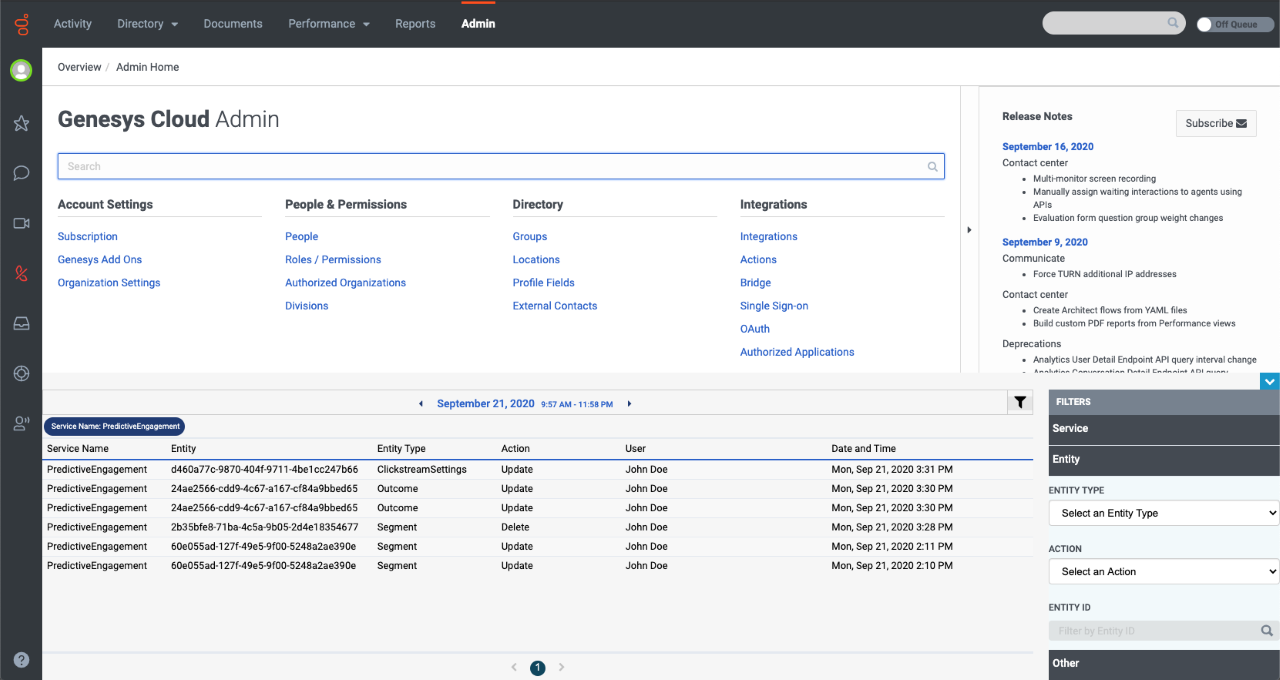Difference between revisions of "ATC/Current/AdminGuide/GDPR"
DannaShirley (talk | contribs) (Published) |
DannaShirley (talk | contribs) (Published) |
||
| Line 50: | Line 50: | ||
==Stop tracking== | ==Stop tracking== | ||
For more information on how to stop tracking if a visitor revokes consent, see {{Link-SomewhereInThisVersion|manual=SDK|topic=Web_tracking_API|anchor=StopTracking|display text=Stop tracking if a customer revokes consent}}. | For more information on how to stop tracking if a visitor revokes consent, see {{Link-SomewhereInThisVersion|manual=SDK|topic=Web_tracking_API|anchor=StopTracking|display text=Stop tracking if a customer revokes consent}}. | ||
| + | ==View audits== | ||
| + | Predictive Engagement events are captured in the audit log. This includes the change history of segments, outcomes, and clickstream settings. For information on how to see these audits, see [https://help.mypurecloud.com/articles/about-the-audit-log-viewer/ About the audit log viewer]. | ||
| + | [[File:Audits.png]] | ||
[[Category:V:ATC:Draft]] | [[Category:V:ATC:Draft]] | ||
Revision as of 10:32, September 22, 2020
Contents
Learn how to use Genesys Predictive Engagement in a GDPR-compliant way.
GDPR compliance
As part of the Genesys Cloud platform, Altocloud complies with GDPR regulations. For more information information about Genesys Cloud and GDPR, see Genesys Cloud and GDPR compliance.
Genesys Cloud provides a GDPR API. The GDPR API as the preferred self-service solution for Genesys Cloud customers to respond to GDPR requests. The GDPR API enables responses to data subject requests to access, rectify, or delete their personal data in Genesys Cloud.
Altocloud considerations
For the purposes of GDPR compliance, Genesys is a data processor on behalf of customers who use the Genesys Predictive Engagement product. You, our customers, are the data controllers of the personal data you collect from your end customers, the data subjects. This article describes how to adhere to GDPR consent requirements, should you identify consent as the most appropriate lawful basis for processing personal data. Note that there is no ‘right’ or ‘wrong’ lawful basis for processing personal data; the GDPR requires that data controllers consider the most appropriate lawful basis. A helpful link for what to consider when determining the most appropriate lawful basis can be found here.
Genesys Predictive Engagement collects data about visitors' activities on business websites. It uses machine learning and AI to analyze customer-generated events (page views, searches, form-fills, and chats) to determine the probability of a specific customer achieving a specific outcome. An outcome is an event the business wants to maximize or minimize. Example outcomes are making a purchase, signing up for a webinar, or filling out a complex form online. For more information about how Genesys Predictive Engagement uses cookies to track visitor activity on websites, see Cookies.
Businesses use end-customer data that Genesys Predictive Engagement collects for three primary purposes:
- Customer support - proactive or AI-driven engagement via chat and callback offers;
- Sales engagement - proactive or AI engagement via chat, callbacks, and content offers;
- Marketing - proactive or AI; for example, sign-up for an event or webinar via content offer.
If you are still unsure as to whether you should obtain the data subject's consent to process their personal data, you may wish to consult your legal advisor.
Conditions for consent
If you have identified consent as the most appropriate lawful basis for processing end customer personal data, then the following conditions should be met when obtaining consent:
- You must be able to demonstrate that the data subject has consented to processing of his or her personal data. That means you should maintain a record or audit trail of consent being given.
- If the data subject's consent is given in the context of a written declaration which also concerns other matters, the request for consent shall be presented in a manner which is clearly distinguishable from the other matters, in an intelligible and easily accessible form, using clear and plain language.
- The data subject shall have the right to withdraw his or her consent at any time. The withdrawal of consent shall not affect the lawfulness of processing based on consent before its withdrawal. Prior to giving consent, the data subject shall be informed thereof. It shall be as easy to withdraw as to give consent.
- When assessing whether consent is freely given, utmost account shall be taken of whether, among other things, the performance of a contract, including the provision of a service, is conditional on consent to the processing of personal data that is not necessary for the performance of that contract.
If you have identified consent as the most appropriate lawful basis for processing end customer personal data, then you should consider what consent has been given before calling the following functions.
The ac('init',...) function starts Genesys Predictive Engagement tracking on your website.
The ac('record',...) function allows Genesys Predictive Engagement tracking of custom user actions on your website.
The ac('identify',...), function is used to identify end-users.
For more information about these functions and others where consent may need to be considered, see [[ATC/Current/AdminGuide/About_tracking|]].
Stop tracking
For more information on how to stop tracking if a visitor revokes consent, see Stop tracking if a customer revokes consent.
View audits
Predictive Engagement events are captured in the audit log. This includes the change history of segments, outcomes, and clickstream settings. For information on how to see these audits, see About the audit log viewer.

